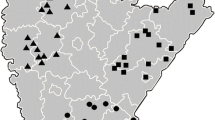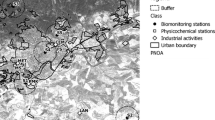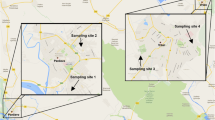Abstract
The aim of this study was to carry out biomonitoring with honeybees (Apis mellifera L.) to assess the presence of pesticides and heavy metals (cadmium, chromium, nickel, lead) in all of the ten nature reserves of the Marche Region (central–eastern Italy). The study was carried out during the spring and summer seasons when the honeybees were active, over 3 years (2008–2010). Twenty-two colonies of honeybees bred in hives were used. Samples of live and dead honeybees and of honey were collected from 11 sampling stations from May to October in each year. No pesticide pollution was found. Significant differences in heavy metal concentrations were found among years, months and sites, and in particular situations. The analysis reveals that high heavy-metal concentrations occurred exclusively in live honeybees. For the seasonal averages, the most detected heavy metal was chromium, which exceeded the threshold more often than for the other elements, followed by cadmium and lead; nickel never exceeded the threshold. The data are discussed with an evaluation of the natural and anthropic sources taken from the literature and from local situations that were likely to involve heavy metal pollution.



Similar content being viewed by others
References
Wolterbeek B (2002) Biomonitoring of trace element air pollution: principles, possibilities and perspectives. Environ Pollut 120:11–21
Conti ME, Botrè F (2001) Honeybees and their products as potential bioindicators of heavy metals contamination. Environ Monit Assess 69:267–282
Rühling Å (1994) Atmospheric heavy metal deposition in Europe—estimations based on moss analysis. NORD 9, Nordic Counsil of Ministers. AKA-Print, A/S, Arhus
Puckett KJ (1988) Bryophytes and lichens as monitors of metal deposition. Biblioth Lichenol 30:231–267
Wolterbeek HT, Bode P (1995) Strategies in sampling and sample handling in the context of large-scale plant biomonitoring surveys of trace element air pollution. Sci Total Environ 176:33–43
Stöcker G (1980) Zu einigen theoretischen und methodischen aspekten der bioindikation In: Schubert R, Schuh J (ed) Bioindikation 1. Methodische und theoretische grundlagen der bioindikation. Martin Luther Universität Halle-Wittenberg, pp 10–21
Lambert O, Piroux M, Puyo S, Thorin C, Larhantec M, Delbac F, Pouliquen H (2012) Bees, honey and pollen as sentinels for lead environmental contamination. Environ Pollut 170:254–259
Atkins EL, Kellum D, Atkins K (1981) Reducing pesticides hazard to honey bees: mortality prediction techniques and integrated management strategies. Division of Agricultural Sciences, University of California, Leaflet 2883
Celli G (1983) L’ape come insetto test della salute di un territorio. In: Arzone A, Conti M, Currado I, Marletto F, Pagiano G, Ugolini A, Vidano C (ed) Atti XIII Congresso Nazionale Italiano di Entomologia. Sestriere, Torino, Italy, pp 637–644
Mayer DF, Lunden JD (1986) Toxicity of fungicides and an acaricide to honeybees (Hymenoptera: Apidae) and their effects on bee foraging behavior and pollen viability on blooming apples and pears. Environ Entomol 15:1047–1049
Mayer DF, Johansen CA, Lunden JD, Rathbone L (1987) Bee hazard of insecticides combined with chemical stickers. Am Bee J 127:493–495
Celli G, Porrini C, Tiraferri S (1988) Il problema degli apicidi in rapporto ai principi attivi responsabili (1983-1986). In: Brunelli A, Foschi S (ed) Atti Giornate Fitopatologiche, Vol. 2. Lecce, Italy, pp 257–268
Celli G, Porrini C (1991) L’ape, un efficace bioindicatore dei pesticidi. Le Scienze 274:42–54
Celli G, Porrini C, Baldi M, Ghigli E (1991) Pesticides in Ferrara Province: two years’ monitoring with honeybees (1987-1988). Ethol Ecol Evol 1:111–115
Porrini C, Colombo V, Celli G (1996) The honey bee (Apis mellifera L.) as pesticide bioindicator. Evaluation of the degree of pollution by means of environmental hazard indexes. In: Proceedings XX International Congress of Entomology, Firenze, Italy, p. 444
Bogdanov S (2006) Contaminants of bee products. Apidologie 37:1–18
Celli G, Porrini C, Frediani D, Pinzauti M (1987) Api e piombo in città (nota preventiva). In: Bufalari V (ed) Atti del convegno: "Qualità dell'aria indicatori biologici api e piante", Firenze, Italy, pp 11–45
Celli G, Porrini C, Raboni F (1988) Monitoraggio con api della presenza dei ditiocarbammati nell'ambiente (1983-1986). Boll dell’Istituto di Entomologia dell’ Università degli Studi di Bologna 43:195–205
Crane E (1984) Bees, honey and pollen as indicators of metals in the environment. Bee World 55:47–49
Fakhim-Zadeh K, Lodenius M (2000) Schwermetalle im honig, pollen und den honigbienen finnlands. Apiacta 35:85–95
Leita L, Muhlbachova G, Cesco S, Barbattini R, Mondini C (1996) Investigation of the use of honeybees and honeybee products to assess heavy metals contamination. Environ Monit Assess 43:1–9
Perugini M, Manera M, Grotta L, Abete MC, Tarasco R, Amorena M (2011) Heavy metals (Hg, Cr, Cd and Pb) contamination in urban areas and natural reserves: honeybees as bioindicators. Biol Trace Elem Res 140:170–176
Porrini C, Ghini S, Girotti S, Sabatini AG, Gattavecchia E, Celli G (2002) Use of honeybees as bioindicators of environmental pollution in Italy. In: Devillers J, Pham-Delègue MH (eds) Honeybees: estimating the environmental impact of chemicals. Taylor & Francis, London, pp 186–247
Satta A, Verdinelli M, Ruiu L, Buffa F, Salis S, Sassu A, Floris I (2012) Combination of beehive matrices analysis and ant biodiversity to study heavy metal pollution impact in a post-mining area (Sardinia, Italy). Environ Sci Pollut Res 19:3977–3988
Stein K, Umland F (1987) Mobile und immobile probensammlung mit hilfe von bienen und birken. Fresenius Z Anal Chem 327:132–141
van der Steen JJM, de Kraker J, Grotenhuis T (2012) Spatial and temporal variation of metal concentrations in adult honeybees (Apis mellifera L.). Environ Monit Assess 184:4119–4126
Zhelyazkova I, Marinova M, Gurgulova K (2004) Changes in the quantity of heavy metals in the haemolymph of worker bees fed micro-element contaminated sugar solution. Uludag Bee J 4:77–80
Porrini C, Sabatini AG, Girotti S, Ghini S, Medrzycki P, Grillenzoni F, Bortolotti L, Gattavecchia E, Celli G (2003) Honeybees and bee products as monitors of the environmental contamination. Apiacta 38:63–70
Celli G, Porrini C, Radeghieri P, Sabatini AG, Marcazzan GL, Colombo R, Barbattini R, Greatti M, D’Agaro M (1996) Honeybees (Apis mellifera L.) as bioindicators for the presence of pesticide in the agroecosystem. Field test. Insect Soc Life 1:207–212
Pilling ED, Jepson PC (1993) Synergism between EBI fungicides and a pyrethroid insecticide in the honeybee (Apis mellifera). Pestic Sci 39:293–297
Komarnicki GJK (2005) Lead and cadmium in indoor air and the urban environment. Environ Pollut 136:47–61
Cempel M, Nikel G (2006) Nickel: a review of its sources and environmental toxicology. Pol J Environ Stud 15:375–382
Kotaś J, Stasicka Z (2000) Chromium occurrence in the environment and methods of its speciation. Environ Pollut 107:263–283
Accorti M, Luti F, Tarducci F (1991) Methods for collecting data on natural mortality in bee. Ethol Ecol Evol 1:123–126
Pisani A, Protano G, Riccobono F (2008) Minor and trace elements in different honey types produced in Siena County (Italy). Food Chem 107:1553–1560
Roman A (2010) Levels of copper, selenium, lead, and cadmium in forager bees. Pol J Environ Stud 19:663–669
Istat (2012) Distribuzione per uso agricolo dei prodotti fitosanitari. Comunicato stampa, 2 ottobre 2012. http://noi-italia.istat.it/fileadmin/user_upload/allegati/69.pdf. Accessed 14 April 2013
Devillers J (2002) The ecological importance of honeybees and their relevance to ecotoxicology. In: Devillers J, Pham-Delègue MH (eds) Honeybees: estimating the environmental impact of chemicals. Taylor & Francis, London, pp 1–11
Seigneur C, Constantinou E (1995) Chemical kinetics mechanism for atmospheric chromium. Environ Sci Technol 29:222–231
World Bank (2002) New ideas in pollution regulation (NIPR). http://www.worldbank.org/nipr/polmod.htm. Accessed 21 December 2012
Soresen MA, Jersen PD, Walton WE, Trumble JT (2006) Acute and chronic activity of perchlorate and hexavalent chromium contamination on the survival and development of Culex quinquefasciatus Say (Diptera: Culicidae). Environ Pollut 144:759–764
Peterson PJ, Alloway BJ (1979) Cadmium in soils and vegetation. In: Webb M (ed) The chemistry, biochemistry and biology of cadmium, vol 2. Elsevier/North-Holland Biomedical Press, Amsterdam, pp 45–92
Barcelo J, Poschenrieder C (1992) Respuestas de las plantas a la contaminacion por metales pesados. Suelo y Planta 2(2):345–361
Yaaqub RR, Davies TD, Jickells TD, Miller JM (1991) Trace elements in daily collected aerosols at a site in south-eastern England. Atmos Environ 25:985–996
Harrison RM, Williams CR (1982) Airborne cadmium, lead and zinc at rural and urban sites in north-west England. Atmos Environ 16:2669–2681
Millward GE, Kadama S, Jha AN (2012) Tissue-specific assimilation, depuration and toxicity of nickel in Mytilus edulis. Environ Pollut 162:406–412
Clayton GD, Clayton FE (1994) Patty’s industrial hygiene and toxicology. Wiley-Interscience Publication, New York
Grandjean P (1984) Human exposure to nickel. IARC Sci Publ 53:469–485
APAT (2010) Annuario dei dati ambientali. Edizione 2010. http://annuario.isprambiente.it/documenti-pdf. Accessed 14 April 2013
ARPAM (2006) Relazione annuale sulle acque superficiali interne. Anno 2006. http://www3.arpa.marche.it/doc/Pdf/acqua/relazionefiumi_2006.pdf. Accessed 14 April 2013
Senesi GS, Dell’Aglio M, Gaudiuso R, De Giacomo A, Zaccone C, De Pascale O, Miano TM, Capitelli M (2009) Heavy metal concentrations in soils as determined by laser-induced breakdown spectroscopy (LIBS), with special emphasis on chromium. Environ Res 109:413–420
Brunialti G, Frati L (2007) Biomonitoring of nine elements by the lichen Xanthoria parietina in adriatic Italy: A retrospective study over a 7-year time span. Sci Total Environ 387:289–300
Acknowledgments
This study was supported by Programma Triennale Regionale Aree protette Regione Marche, 2008–2010, within the project “Use of Apis mellifera in biomonitoring of Nature Reserves.” The comments and suggestions made by three anonymous reviewers helped us to improve this manuscript.
Author information
Authors and Affiliations
Corresponding author
Electronic supplementary material
Below is the link to the electronic supplementary material.
ESM 1
(DOCX 198 kb)
Rights and permissions
About this article
Cite this article
Ruschioni, S., Riolo, P., Minuz, R.L. et al. Biomonitoring with Honeybees of Heavy Metals and Pesticides in Nature Reserves of the Marche Region (Italy). Biol Trace Elem Res 154, 226–233 (2013). https://doi.org/10.1007/s12011-013-9732-6
Received:
Accepted:
Published:
Issue Date:
DOI: https://doi.org/10.1007/s12011-013-9732-6




